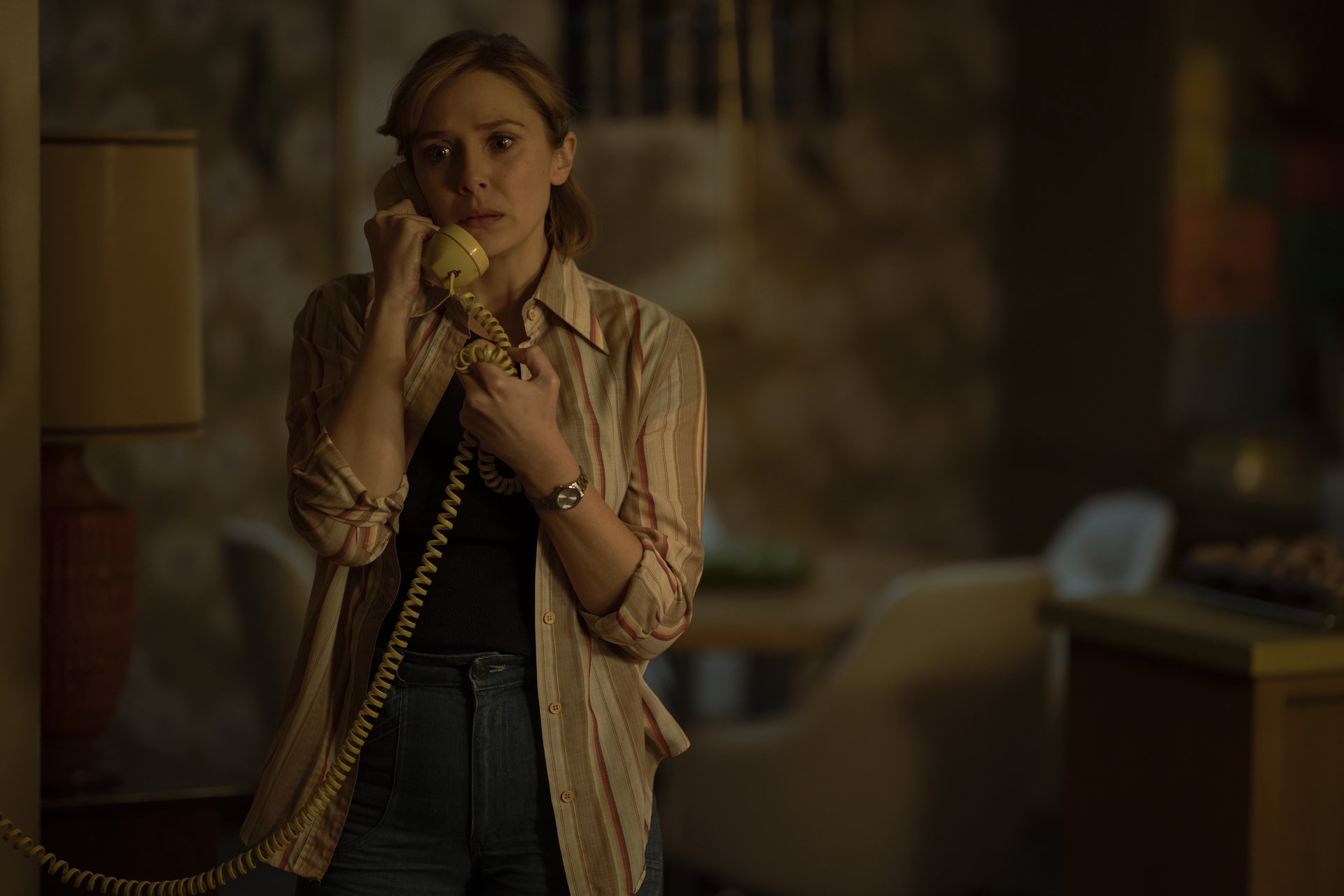'Love & Death' Review: Elizabeth Olsen Shines In True Crime HBO Series
Death and taxes love.
Elizabeth Olsen in Love & Death. Courtesy of HBO Max.
Editor’s Note: This review is based on all seven episodes of Love & Death, provided to TWM for review by HBO Max.
Few things are guaranteed in life. If you were to refer to the popular saying, you’d be met with death and taxes, and if you ask any one person, the answer could be very different. While I’m not here to comment on life and mortality, I can say that if one thing is guaranteed, it’s death. For Betty Gore, that was certainly the case. On June 13, 1980, Betty Gore was murdered. She was struck 41 times by a wood-splitting axe, leaving one of the goriest crime scenes in modern history. This story has been told before. It was told in the 1984 articles by the Texas Monthly and was told on screen in last year’s Candy, a 5-part limited series from Hulu. That said, it’s never been told in the way that it is now with Love & Death. The series follows Candy Montgomery (Elizabeth Olsen), a young mother and wife in Wylie, Texas, who wants more from her life and marriage. Candy lives what many in her town would consider the perfect life. She has two kids with her husband Pat (Patrick Fugit), is primarily a stay-at-home mom, volunteers for the church, and is a member of the church council. Unfortunately for Candy (more so her husband), she always seems to want more. In this case, she finds more in the form of Allan Gore (Jesse Plemons), a father and member of her church, who she collides with during a church volleyball match. This leads to her beginning an affair with Allan. For the two, all seems to be going well for a while until Allan’s wife, Betty (Lily Rabe), is found murdered — chopped up by an axe.
Elizabeth Olsen & Jesse Plemons in Love & Death. Courtesy of HBO Max.
After the opening credits, each episode begins with the title card “This Is A True Story.” While bold, this decision from the filmmakers is effective, grounding the series in (slightly altered) realism that remains constant throughout all seven episodes. The series makes the choice not to glamourize its events, a strong choice given how impressionable audiences can be, and promoting adultery wouldn’t be a great takeaway for a series. That said, what can be taken away from the series is simply how well-made it is. The series takes on the difficult task of having to deal with the internet. Because the seven episodes are directly adapting true events, if a viewer gets bored, they can simply find the nearest device and look up “Candy Montgomery,” and be met with a plethora of summaries of this tale from primary, secondary, and tertiary sources. Thankfully, Love & Death is so captivating and well-structured that it doesn’t face this issue at all — even if a post-watch Google search may be beneficial to get important historical context. Seven episodes aren’t the typical length for a series — even limited ones. Usually, studios stick to round numbers, structuring shows for six, eight, or 10 episodes. However, I can’t complain about the series’ length, as Love & Death is perfectly structured. It knows exactly where to start and end episodes, what makes good cliffhangers, and how to draw us into a story and keep us hooked with well-placed flashbacks (and flash-forwards).
Without a strong, likable lead, a series like Love & Death would be instantly doomed. Fortunately for HBO Max, they’ve found a perfect performer for the role of Candy Montgomery in Elizabeth Olsen, who delivers a career-best performance. The obvious reference to the strength in Olsen’s performance is the scenes that require high energy and intensity, i.e., the “Oscar-bait” scenes. However, the first instance of Olsen’s powerhouse performance comes in the first episode, and it’s when she’s not talking at all. It happens in the aforementioned volleyball scene when Candy and Allan bump into each other. All we need is the look on her face and the subtle movement of her eyes to instantly understand the emotions she’s feeling and the thoughts running through her head. That said, one good performer doesn’t make for a good series, and in this case, Olsen is met by the great Jesse Plemons, whose performance is more restrained — not taking the spotlight but being there as a guardrail for the tone of this torrid affair. Tom Pelphrey (Ozark) gets his turn in the final episodes, playing the witty yet charming defense attorney who’s in way over his head.
Elizabeth Olsen in Love & Death. Courtesy of HBO Max.
I say this in hopes of answering your question — and the reason you clicked on this review — is Love & Death good? Yes. From a technical standpoint, it’s a well-shot, thoughtfully crafted limited series and is backed creatively by its writing, directing, and acting, which are all notably strong. Love & Death knows when to hold back information and when to put it all out there, and the result is ~seven riveting hours of television. I’m not a sucker for the true crime genre by any means, but once I got through the introductory section of Love & Death, it was hard to put down. If I had one thing to say about Love & Death, it’s this: I did my research before watching the show. I read the original articles, scrolled through Wikipedia, and familiarized myself with the events of the series, forming opinions about the people involved with said events. Love & Death changed my perspective on these events entirely, making me consider the case through a different lens.
Love & Death premieres with three episodes on HBO Max on April 27, with episodes releasing weekly through May 25.



